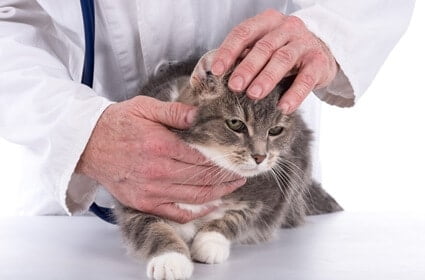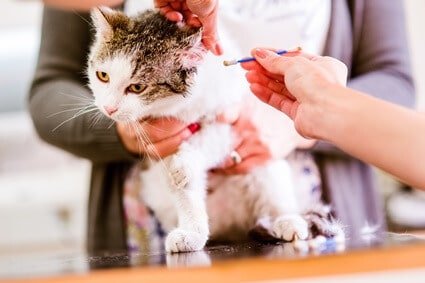If you’ve ever snuggled with your cat and brushed its ears, you might’ve been surprised by the warmth. Cat ears are almost hot to the touch, especially in contrast to a human’s body temperature. That can leave owners worried that their feline is sick or feverish. However, it’s usually normal. As long as the ears don’t feel scorching and your cat has no other medical symptoms, you don’t need to worry about anything.
Cats have hot ears because of their naturally elevated body temperature. A cat should have an internal range of between 100-102.5 degrees Fahrenheit. This is higher than a human’s normal body temperature and would thus feel hot to us. Your cat’s ears will become hotter during the warmer months due to their sensitivity to temperature or weather changes. Of course, a feline with a fever may also have extra hot ears, so check for other symptoms.
An ill cat will also display panting, a refusal to eat or drink, lethargy, excessive itching, or vomiting. In this case, hot ears also indicate that your cat is overheating. It may be sick due to an allergic reaction, heatstroke, an infection, ear mites, or hyperthyroidism. Its body will then raise its internal temperature to try and burn this illness out. Since the skin and fur on your cat’s ears are thinner than elsewhere on its body, you’ll notice the heat difference here first.
What Does It Mean When Cats Have Hot Ears?
If your cat has hot ears, in most cases, it just means that the cat is healthy and well-balanced. It’s entirely natural since your cat’s body temperature is higher than your own. In fact, cats have naturally evolved to have a warmer internal body temperature.
Domestic cats were originally descended from roaming desert cats that hardly had any access to water. As such, they displayed a lack of a strong thirst drive. That would make these ancient cats avoid drinking a lot of water, even when they needed it. Instead, the cats relied on gaining it from food since meals were more plentiful than oases. That trait has been passed on to your average house cat.
According to Physiological and Biochemical Zoology, dehydrated animals tend to have increased body temperatures. That’s especially true if researchers simulated desert-like conditions when studying their animal subjects. Because cats have not been as thoroughly bred as dogs, they still retain the lack of a thirst drive from their desert cat ancestors. That all results in your cat having much hotter ears.
Of course, this does not mean that your cat will have cooler ears if it drinks more water. This is your cat’s natural state. Its body adapted to a lack of water, which is a mere byproduct of that survival tactic.
However, that’s only true if your cat shows no other symptoms. Cats are still able to develop fevers, which is usually a result of illness. The problem is, you may be unable to tell the fine difference between hot ears and feverish ears in a cat. As such, you need to look for additional signs to tell if your cat is normal or sick.
Is It Normal for a Cat to Have Hot Ears?
In cats, hot ears are not only an evolutionary byproduct. They’re also an active way for your cat to protect itself from the cold. A cat’s ears are just as susceptible to temperature changes as the rest of its body. Indeed, the ears are not covered in much fur or any fat. Because of this, the thin tissue is even more sensitive to these changes.
Oftentimes, a cat’s ears will vasodilate when it is warmer outside and vasoconstrict in the colder months. Vasodilation occurs when the blood vessels increase blood flow around the body to relieve excess internal body heat. Vasoconstriction is when the blood vessels constrict to retain heat to the more important parts of your cat’s body. This is mainly the head and torso.
Essentially, your cat’s ears should feel warm if they are vasodilated and much cooler if they are vasoconstricted. This can help your cat avoid damaging its ears when it runs around in cool weather. It can also help your feline avoid overheating when it sunbathes in a cozy window.
Therefore, it is best to feel your cat’s ears when it rests in a sunny location. Its ears may still feel warm to you but not burning or hot like the cat is running a fever. If its ears feel much too hot and your cat is panting, this might be a sign of heatstroke. You can help it cool down by:
- Rubbing its body with water
- Adding ice chips to its water bowl
- Turning on a fan or your air conditioner
Is It Bad If Your Cat’s Ears are Hot?
It’s usually not a bad thing for a cat’s ears to feel hot. Hot ears, in conjunction with other symptoms, can signal illness. Your cat is definitely sick if it’s:
- Isolating itself more than usual
- Not eating or drinking as much
- Breathing rapidly
More astute owners may also notice that their cat’s coat is duller. If its skin stretches out but does not snap back immediately, that is a sign of dehydration.
Keep in mind that most cats will try to hide any signs of illness, as they consider it a weakness on their part. Sick cats in the wild are often attacked by larger animals or even killed as prey. Although your cat may know you and your family are not a danger, it may still feel the need to hide away until it starts to feel better.
As such, if you notice the obvious symptoms listed above, you should keep a careful eye out. Extra signs will help you narrow down what’s wrong with your cat.
Allergic Reactions
Your cat’s hot ears might be an allergic reaction to something around your home. Allergies are reflected more across the skin and ears in felines rather than outright sneezing or sniffling. You might notice your cat scratching at its ears more often as well. Possible allergens for a cat may include:
- Pollens from trees, weeds, and grass
- Dust
- Mold and mildew spores
- Food allergies
- Flea bites
- Certain medications, shampoos, soaps, or other cleaning products you use
- Perfumes
- Smoke
- Certain surfaces, such as specific woods, fabrics, or plastics
Taking your cat to see the veterinarian can help both of you figure out what exactly your cat might be reacting to. That way, you can do your best to help your cat avoid these allergens in the future.
Signs of Fever
Hot ears are one of the main signs that your cat is battling a fever. Of course, if your cat seems to move around just fine and is eating and drinking consistently, then don’t worry. You might’ve just confused hot ears with feverish ears. To make sure, keep an eye on its behavior throughout the day. It may be running a fever, but hiding it, if the cat:
- Isolates itself away from you and your family
- Doesn’t eat much
- Spreads itself out rather than curls up
- Has an excessively warm stomach or underarms
Fevers are not usually something to worry about in the long run. They typically arise when your cat’s body is trying to fight off viruses, bacteria, or other mild illnesses. This fever should go away on its own over the course of a day or two. However, if your cat’s fever persists for more than 2 days, other factors are at play.
Your cat’s fever may be due to a bacterial infection from an injury or source of trauma that you should be able to find. If you have ruled out any visible injuries or clear signs of illness, then your cat will have a fever of unknown origin.
This is sometimes referred to as FUO by veterinarians. It’s wise to take careful note of all physical and behavioral changes your cat has exhibited. This will help your veterinarian figure out the cause of your cat’s fever more quickly.

Signs of Heat Stroke
According to the Journal Of Veterinary Emergency And Critical Care, a cat will experience heat stroke if its body temperature reaches 106 degrees Fahrenheit or higher. You will notice other symptoms on top of its hot ears as well. This includes:
- Lethargy or other signs of weakness
- Excessive panting
- Vomiting
Heatstroke can prove to be very damaging because it can quickly dehydrate your cat. This can be harmful, especially for cats that rarely drink much water, to begin with. Heatstroke can also cause:
- Cerebral edema (swelling of the brain)
- Bone marrow suppression (which results in a decrease in the production of red and white blood cells)
- Increased metabolism
- Breakdown of muscle tissues
- Blood clotting disorders
Signs of Infection
An ear infection can easily make your cat’s ears swell or become inflamed and red. That will make them feel hotter to the touch. Your cat may scratch at its ears a lot or rub its head against furniture to relieve itself of the unpleasant itching. That can worsen the problem.
Your cat may also shake its head and have excessive amounts of ear wax fall out. That will create an unpleasant smell. You can spot this early by performing an ear examination of your own every now and then. The hairless part of your cat’s ears should be clean and free of any strange odors. Your cat has an ear infection if you notice that they’re:
- Red from excessive scratching
- Flaking
- Scabby
- Produce discharge
Excess earwax, yeast, or other build-up is also likely to raise the temperature of your cat’s ear canal as well as the outer ear, also known as the pinna. If you ignore these symptoms for too long, your cat’s eardrum may be damaged. Thus, you need to schedule an appointment with your vet to preserve your cat’s hearing.
Signs of Ear Mites
If your cats’ ears are hot and itchy, then this could be a sign that they have ear mites. Ear mites tend to spread fairly easily among domestic cats. That’s why it’s so important to get it under control the moment you notice your cat itching its ears.
A simple inspection of your cat’s ears every now and then should help verify the issue. Ear mites can easily be identified as a black, gritty-looking substance. They will look somewhat like coffee grounds inside your cat’s ears.
Other signs of ear mites include inflammation on your cat’s ears, making them feel warm or hot to the touch. These mites will feed on your cat’s ear tissues, ear wax, and other debris found in its ear. If left to fester for too long, these mites can cause ear infections or damage your cat’s hearing.
Signs of Hyperthyroidism
Hyperthyroidism is a health condition that commonly affects older cats. Hyperthyroidism is basically when your cat has an overactive thyroid gland, which drastically raises its metabolism levels. According to the Journal of Applied Physiology, cats will redistribute their internal body heat whenever their metabolism increases. That can result in:
- Increased body temperatures
- Elevated heart rate
- Increased appetite
- Weight loss despite an increase in food consumption
- Restless or aggravated behavior due to hunger and especially hot ears
Hyperthyroidism is nothing to scoff at. If you do not bring your cat in to see its veterinarian, this condition can eventually lead to secondary hypertension. That is basically high blood pressure caused by another condition (such as hyperthyroidism), and heart failure.
Should a Cat’s Ears be Hot or Cold?
Your cat’s ears should feel relatively warm most of the time. That’s because a cat’s internal body temperature will range anywhere between 100-102.5 degrees Fahrenheit.
Cat ears will feel quite warm to us humans, who have an internal body temperature of around 98.6 degrees Fahrenheit. Below is a handy table for you to check to see if your cat’s internal body temperature is healthy or not.
| Body Temperatures | Effect on Your Cat |
|---|---|
| Less than 100 degrees Fahrenheit / 37.8 degrees Celsius | Hypothermia |
| 100 degrees Fahrenheit – 102.5 degrees Fahrenheit / 37.8 degrees Celsius – 39.2 degrees Celsius | Normal internal body temperature for cats |
| 103.5 degrees Fahrenheit+ / 39.7 degrees Celsius+ | Fever or other illnesses |
| 106 degrees Fahrenheit+ / 41.4 degrees Celsius+ | Heat stroke |
If you feel that your cat’s ears are especially hot, then it is a good idea to learn how to take its temperature. Unlike humans, cats can only have their temperature taken rectally. This is obviously not a pleasant experience for your cat, so you will need to make it as quick and easy as possible.
- Apply Vaseline or another lubricant on the thermometer.
- Distracting your cat with treats beforehand.
- You may also need the help of a trusted family member or friend to hold your cat down during this process.
It is best to use a digital pediatric rectal thermometer, as opposed to a glass one. Not only are these thermometers more accurate. They will also be safer to use in case your cat moves around too much. Here’s how:
- You must insert the thermometer inside slowly so that its sphincter has a chance to loosen a bit.
- Stop once the thermometer is 1 inch within the rectum.
- Slowly take it out again once the thermometer reads.
- Once you’re done, feed your cat more treats and give it space if needed.
- You should also thoroughly clean the thermometer with rubbing alcohol after each use.
If your cat’s temperature is only slightly above average, your cat should be fine. If it is much higher than normal, you will need to take your cat to the veterinarian. An expert will be able to prescribe any medications your cat might need. The vet can also help you figure out what caused your cat’s hot ears or other illnesses in the first place. These triggers can then be avoided or removed from your home altogether.

Why is One of My Cat’s Ears Hot?
It’s not concerning if only one of your cat’s ears is hot, while the other is normal or even cold. This can mean that your cat’s body is trying to regulate its internal temperature.
One side of your cat might be exposed to cold air and the other to a warmer source, like a heater or sunny windowpane. That could explain this small difference. It’s also possible that its ears are confused about which temperature it should keep its body at. That will result in one cold ear and one warm ear.
On the other hand, your cat may also have poor blood circulation in its ears. If your cat’s ears feel cold in cold weather or especially warm in warmer weather, this is worth being concerned about. Your cat may have something wrong with its cardiovascular system, which will call for the intervention of your vet.
What if My Cat’s Ears are Cold?
On the flip side, if your cat’s ears are much colder than they should be, this can present its own array of challenges. For instance, a feline can easily get hypothermia if its internal body temperature falls anywhere below 100 degrees Fahrenheit. In this case, its heart rate and overall body activity will also fall. Your cat may even descend into a coma if you are not careful.
If one of your cat’s ears is warm, but the other is very cold, this might not be a cause for concern. You may need to bring your cat away from the cold source to warm back up again. However, if your cat is visibly shivering, breathing very slowly, or the rest of its body feels cold, then the one hot ear is an outlier in the situation.
- You need to get your cat to a warm place as quickly as you can.
- If your cat is also wet, you need to dry it off with warm towels and blankets.
- Try to coax your water to drink warm water or place warm water bottles nearby.
- While you try to warm it back up again, call your veterinarian and try to get them to see your cat right away. Acting quickly might prevent your cat from slipping into a coma or worse.
If your cat only has a mild case of hypothermia, then using all the methods at your disposal to warm it back up again should suffice. However, in more moderate or severe cases, your veterinarian might set up an IV with warmed fluids or inject a warm water enema to warm your cat from the inside out. Your cat should make a swift recovery soon after, but it is still a good idea to watch how it acts a few days following this procedure.

